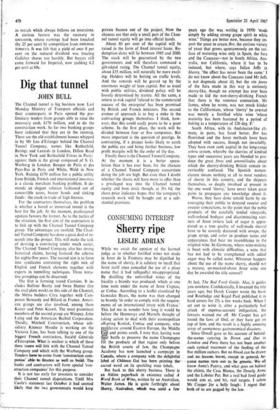Dig that tunnel
JOHN BULL
The Channel tunnel is big business now. Last Monday Ministry of Transport officials and their counterparts in Paris opened the pre- liminary tenders from groups able to raise the necessary cash, £170 million, and to do the construction work. So far two banking groups have indicated that they are in the running. There are the old establishment houses whipped in by Mr Leo d'Erlanger behind the Channel Tunnel Company, names like Rothschild, Barings and Lazards in London, Dillon Read in New York and Rothschild Freres in Paris: against them is the group composed of S. G. Warburg in London, Banque de Paris et des Pays-Bas in Paris and White, Weld in New York. Raising £170 million for a public utility from British, French and international investors is a classic merchant banking problem. It de- mands an elegant solution fashioned out of convertible notes, bearer bonds and sinking funds: the stock-in-trade of high finance.
For the contractors themselves, the problem is whether a bored or immersed tunnel is the best for the job. At the moment, professional opinion favours the former. As to the tactics of the situation, the first aim of the contractors is to link up with the Channel Tunnel Company group. The advantages are twofold. The Chan- nel Tunnel Company has done a great deal of re- search into the project. This will make the task of devising a convincing tender much easier. The Channel Tunnel Company also has strong historical claims, having fostered the scheme for eighty-five years. The second aim is to form into syndicates containing the right mix of English and French elements together with experts in tunnelling techniques. Three tenta- tive groupings can be discerned.
The first is forming round Costains. It in- cludes Balfour Beatty and Swan Hunter (for the steel plate work) on this side of the Channel, the Metro builders Citra together with Cam- penon Bernardy and Billard in France. Ameri- can groups are also involved, among them Kaiser and Peter Kiewit. The most prominent members of the second group are Wimpey, John Laing and the American Bechtel Corporation. Thirdly, Mitchell Construction, whose sub- sidiary Kinnear Moodie is working on the Victoria Line, has been talking to one of the biggest French contractors, Societe Generale d'Entreprise. What is unclear is which of these three teams will link with the Channel Tunnel Company and which with the Warburg group. Tenders have to come from 'construction-com-
panies' able to finance, as well: build: The banks and contractors will form special 'con- struction companies' for this purpose.
It is not too early for investors to consider their Channel tunnel dispositions. Until Mrs Castle's statement last October it had seemed likely that the two governments would keep private finance out of the project. Now the chances are that only a small part of the Chan- nel tunnel equity will go into official hands.
About 80 per cent of the capital will be raised in the form of fixed interest loans. Re- demption dates will lie between 1985 and 2000. The stock will be guaranteed by the two governments and will therefore command a gilt-edged rating. The Channel tunnel equity, about £35 million, will naturally be more excit- ing. Holders will be betting on traffic levels. And the rewards will be geared up by the enormous weight of loan capital. But as usual with public utilities, dividend policy will be loosely determined by statute. All the same, a return to risk capital 'related to the commercial success of the enterprise' has been promised by British and French ministers. The second avenue of approach is to buy a stake in the, contracting groups themselves. I think, how- ever, that this could easily prove to be a poor scheme. In- the first place, the work .will be divided between four or five companies. But more important is the question of prestige. In contracting, if a project looks likely to catch the public eye and bring further business, low profit margins will be the order of the day.
Finally there is the Channel Tunnel Company. At the moment it is a better specu- lation than it has ever been, for the chances of a Channel Tunnel Company consortium doing the job are high. But even then I doubt whether the shares will have more to offer than a privileged way into the Channel tunnel equity and loan stock though, at 31s 6d, the share price indicates hopes that the company's research work will be bought out at a sub- stantial premium.






































 Previous page
Previous page